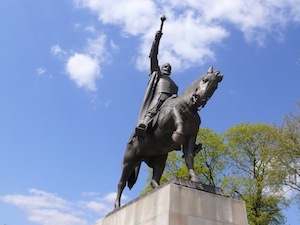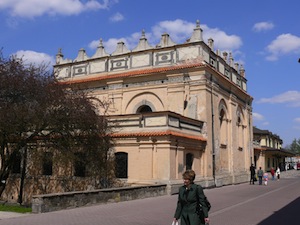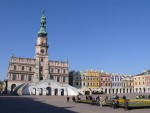Zamosc town hall. (photo by Tomasz Zugaj)
If you were rolling in money, what would you do with it? Would you build a town for yourself? That’s what Jan Zamoyski did.
As you approach the town’s main square, you might be inclined to think that someone has fooled with your itinerary. On first glance, it might well appear that somehow you have been detoured from Poland to Italy. Before you stands Zamosc, which can only be described as a stunning example of a planned, late-16th century Renaissance town. Designed by Italian architect Bernardo Morando, it follows the model of the citta ideale, or ideal town.
More than 400 brutal years have passed since the town’s inception. Yet, Zamosc has remarkably withstood the enormous devastation of the Second World War and the utilitarian, unesthetic architecture of the communist era. It largely retains its original layout, a large number of original buildings and fortifications.
Zamosc stands in southeast Poland, 142 miles (228 kilometres) from Warsaw. Zamoyski founded Zamosc on his own property in 1589. He was an intriguing character, an extremely wealthy and educated man who juggled a variety of careers, including in the military and politics. He was a hetman (head of the army) and a chancellor. His taste in things Italian probably began during his student days at the University of Padua.

While he was an army man, Zamoyski’s focus in establishing Zamosc was seemingly more economic than military. It should be noted, however, that he did not forget to commission an imposing fortress and city ramparts.
Located on the trade route linking western and northern Europe with the Black Sea, Zamoyski envisioned Zamosc as a thriving trade centre. He invited Italian, Turkish and Dutch Jewish merchants to work and live in his new town. His liberal policy toward outsiders was likewise extended to Armenian, Greek and Scottish merchants, and to Ruthenes (Slavs of the Orthodox Church). His outreach to foreigners did not spring as much from liberality, as from a strong desire to see Zamosc succeed. At the time, all of the mentioned ethnic groups had reputations for jump-starting floundering economies.
Zamoyski’s concerns went beyond the economic, though. As an intellectual ruler who was likewise a devout Roman Catholic, he had an academy – located today at Academy and Perec Streets – a high court and a large church, which was originally dedicated to Saint Thomas the Apostle and the resurrection, but was elevated in 1992 to cathedral status, and an imposing palace centrally constructed. Altogether, Zamosc’s buildings reflect the idea that institutions should be in physical harmony with the residents of a town. Just as the organs of the body support the human being, so Zamosc’s institutions were designed to organically mesh with the populace.
As mentioned, when Zamoyski decided to build his town, he imported a skilled Italian architect. It seems clear, however, that the chancellor also considered Morando because of his sensitivity to Polish culture. Morando had already worked in Poland and had gained an appreciation of Polish life.
The 16th-century Great Market Square features colorful arcaded houses characteristic of Morando’s native Padua. These houses, located at the northern end of the square, were designated for the Armenian merchants, hence the street’s name, Ormianski.

In length and width, the square measures exactly 100 metres. It is here that the two main axes of the old town cross. The 600-metre longitudinal axis runs east to west: from Bastion No. 7 to the Zamoyski Palace. The 400-metre crosswise axis runs north to south, joining the Great Market Square to the two smaller market squares: Solny (this area, translated as the Salt Market, was assigned to Jewish merchants) and Wodny (translated as the Water Market). The original buildings in these smaller markets complemented those of the Great Market.
The town hall in particular was an enormous enterprise, taking nine years to complete (1591-1600). It was meant to draw attention. And, with its fan-shaped double staircase and imposing tower, it certainly achieved this purpose. During the early part of the construction work (1591-1593), Morando also served as the town mayor. His appointment ended before he was able to hang his name on the door of town hall’s mayoral offices.
In 1992, the town of Zamosc became a UNESCO World Heritage site. Hopefully, this award will help to preserve the beauty of this Renaissance town for years to come.
More on Zamosc
- From July 11 to July 18, Zamosc is hosting the international folklore festival Eurofolk. About seven international carriers fly regularly between Vancouver and Warsaw.
- Famous people who lived in Zamosc include L.L. Zamenhof, founder of Esperanto. He had the revolutionary idea that hatred would disappear if people spoke the same language. A revolutionary who was born in Zamosc was Rosa Luxemburg.
- The old town of Zamosc stands largely intact. Humans fared far worse. For instance, the Jewish population, which had comprised almost half the city’s pre-Holocaust population (12,531), has vanished. Those who could, fled from the Nazis. Others were forced into a ghetto. In a series of four deportations, many Jews were sent to Belzec. Others were shot in marches and in roundups. As a reminder of the once-thriving Jewish community, visit the synagogue (9-11 Zamenhofa St.), which has been undergoing an extensive renovation project.
Deborah Rubin Fields is an Israel-based features writer. She is also the author of Take a Peek Inside: A Child’s Guide to Radiology Exams, published in English, Hebrew and Arabic.

